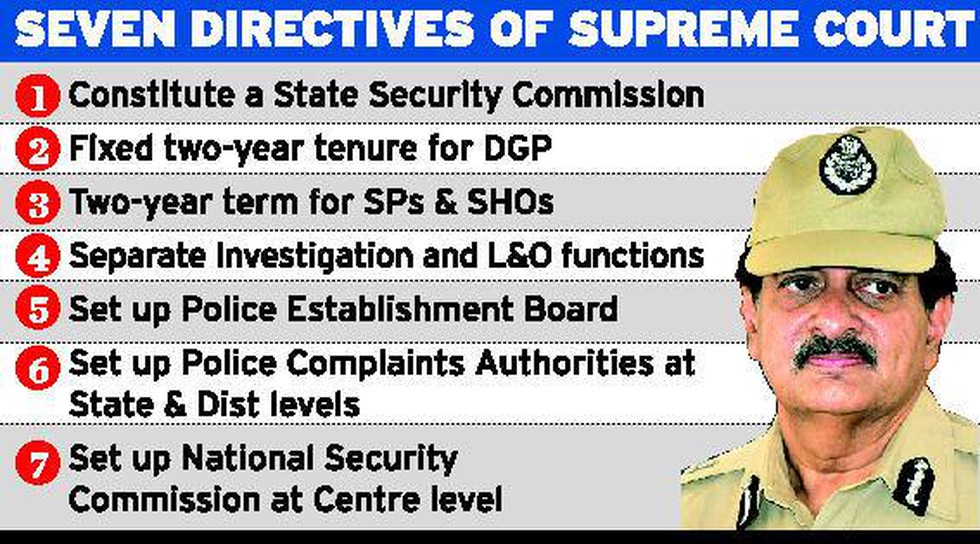Indian Polity
Police Reforms In Indian Criminal Justice System
This article is based on the “Thoothukudi to Kanpur: The police are in the dock. Reforms must start with the political system” which was published in The Indian Express on 14/07/2020. It talks about the need for police reform in the criminal justice delivery system.
Recent custodial death of a father and son by police in Tamil Nadu and the death of a gangster (with alleged political connections) in an encounter by Uttar Pradesh police has put a question mark on objectivity and credentials of the police in delivering justice.
Factors responsible for atrocities done by police and criminals evading the criminal justice system range from their political nexus to inefficiency of police.
This can be also reflected in the Vohra Committee report, that highlighted the nexus between the criminals, politicians and government functionaries. It stated that the network of the mafia is virtually running a parallel government, pushing the state apparatus to irrelevance, and suggested that an institution be set up to effectively deal with the menace.
Thus, there is a need to decriminalise politics and bring about a number of reformations in the criminal justice system including the police reforms.
Issues Related to Functioning of Police
- Political Criminalisation Nexus: Second Administrative Reforms Commission (2007) has noted that the excessive power in the hands of police has been abused in the past by the political executive to unduly influence police personnel, and have them serve personal or political interests.
- Further, there has been an increasing phenomenon of criminalisation of politics.
- This nexus interferes with professional decision-making by the police (e.g., regarding how to respond to law and order situations or how to conduct investigations), resulting in a biased performance of duties.
- An Overburdened Police Force: State police forces had 24% vacancies (about 5.5 lakh vacancies) in January 2016. Hence, while the sanctioned police strength was 181 police per lakh persons in 2016, the actual strength was 137 police.
- This is way too low when compared with the United Nations’ recommended standard of 222 police per lakh persons.
- Further, an average policeman ends up having an enormous workload and long working hours, which negatively affects his efficiency and performance.
- Need to set Police accountability: In India, various kinds of complaints are made against the police including complaints of unwarranted arrests, unlawful searches, torture and custodial rapes.
- To check against such abuse of power, various safeguards should be adopted, such as accountability of the police to the political executive, internal accountability to senior police officers, and independent police oversight authorities.
- Lack of Resources: CAG audits have found shortages in weaponry with state police forces. For example, Rajasthan and West Bengal had shortages of 75% and 71% respectively in required weaponry with the state police.
- Also, the Bureau of Police Research and Development has also noted a 30.5% deficiency in stock of required vehicles with the state forces.
- Further, funds dedicated to the modernisation of infrastructure are typically not utilised fully. For example, in 2015-16, only 14% of such funds were used by the states.
Ways Forward
- Curbing Criminalisation of Politics: The criminal nexus with politics will have to be broken and reforms must start with the political system. Thus, there is a need for laws which debars persons with serious criminal cases from entering the assemblies and the Parliament.
- Revamping Criminal Justice System: There is a need to incorporate the Menon Committee and Malimath Committee recommendations for devising a national policy paper on the criminal justice system. Some of the key recommendations are as follows:
- Creation of a fund to compensate victims who turn hostile from the pressure of culprits.
- Setting up of separate authority at the national level to deal with crimes threatening the country security.
- A complete revamp of the entire criminal procedure system.
- Independent Complaints Authority: The Supreme Court has observed that there is a need to have an independent complaints authority to inquire into complaints of police misconduct.
- The Model Police Act, 2006 requires each state to set up an authority comprising retired High Court Judges, civil society members, retired police officers and public administrators from another state.
- Implementing the Supreme Court’s Directive: The Supreme Court’s directions in Prakash Singh case 2006 on police reforms must be implemented. The court laid out seven directives where considerable work in police reforms is still needed.
Conclusion
The issues of Police are the manifestation of the limitations of the Indian political and social setup. Thus, there is a need to carry out Police reforms and incentivise police department to adopt best practices. Along with that, without further delay, there is a need to build an environment where police become an instrument of service to the people.
|
Drishti Mains Question Police reforms are the sine qua non to make Indian justice delivery system more efficient. Comment. |
This editorial is based on “Gains from rains: on monsoon performance” published in The Hindu on July 14th, 2020. Now watch this on our Youtube channel.





